Having spent some of my formative years in London during the latter days of its glorious smogs, Canadian air has often proved disappointing. What is the value of fresh, clean air one can breathe easily? Air that is eerily invisible to the eye? Air that doesn’t cover exposed surfaces with a layer of soot? Happily, decades of clear-eyed world environmental policy seem to be paying off in the form of choking, eye-watering smoke drifting to nations across the northern hemisphere.1
For your consideration, here are some SF novels about air.
The Burning World by J. G. Ballard (1964)
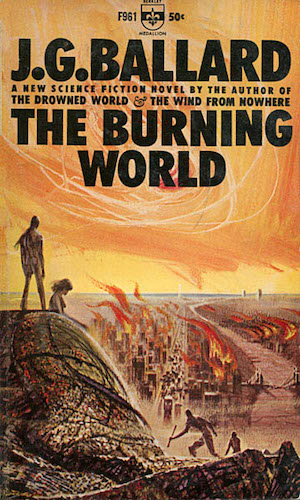
Earth has long suffered under the precipitation cycle, in which water flowing into oceans evaporates, only to fall once more in the form of rain. Human ingenuity puts a halt to this dismal state of affairs by providing the oceans with an impermeable layer of pollution. No evaporation means an end to rain’s tyranny!
Forever ungrateful, humans do not celebrate this liberation, preferring to obsess over their impending death by thirst. Millions flee towards the ocean. Dr. Charles Ransom resists, but in the end, the urge to survive will send him on the same pilgrimage, down towards the unfriendly sea.
Readers wondering if this all leads towards a eucatastrophe in which disaster births a hopeful new world should bear in mind that this is a J. G. Ballard story. On the bright side, perhaps the drought will prove no more serious than the End Permian extinction…that is, from the perspective of lifeforms existing a quarter billion years later.
The Nitrogen Fix by Hal Clement (1980)
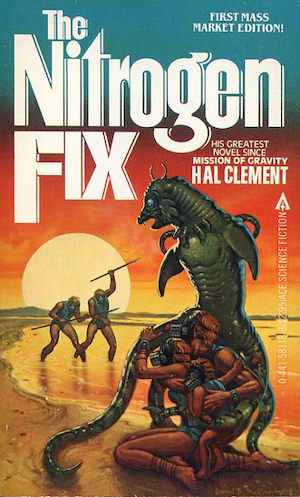
Pseudolife, replicating artificial chemicals analogous to the life we know and treasure (save when the profit motive dictates otherwise), provided humanity with a nigh godlike ability to transform the Earth. Coincident with the development of pseudolife, the atmosphere of the Earth was transformed, corrosive oxygen bound up safely in oxides of nitrogen. It’s a virtual paradise, unless for some reason one needs oxygen to breathe.
This new Earth is a challenging environment in which Nomads Kahvi and Earrih are raising daughter Danni. How fortuitous for the family that they allied with Bones, an alien who is better suited to current-day Earth than are the humans. How unfortunate that the sedentary Hillers are convinced Bones is an enemy, and that anyone travelling with the octopoid is likewise worthy of suspicion.
Clement used pseudolife in a number of otherwise unrelated stories. In many of them, humans are careful to prevent runaway pseudolife growth, no doubt to avoid scenarios like that in The Nitrogen Fix.
It is eventually proposed that pseudolife isn’t the culprit here, but rather an entirely different substance.2
The Last Gasp by Trevor Hoyle (1990)
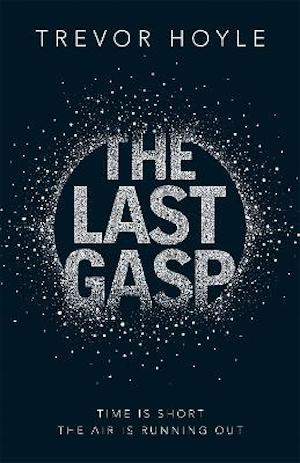
The world of the late 20th and early 21st century is gripped in the seemingly endless conflict between the United States (and its allies) and the Soviet Union (and its allies). It should come as no surprise that the combatants in this endless cold war should have become adept at suborning every conceivable field and claiming it for the great struggle. This includes the environmental sciences.
Lloyd Madden has a grand vision for a transformed Earth. Scientists Gavin Chase and Cheryl Detrick, obsessed as they are with the potentially catastrophic elimination of oxygen from the atmosphere, present a serious impediment for Madden. However, Madden is not merely a visionary. He is very rich. Gavin and Cheryl may want to save the world, but they will be doing well to save themselves.
The novel seems to present Madden as an antagonist. However, he is very rich. Since we all know that moral worth is equal to monetary wealth, the novel’s bizarre conviction that it is somehow bad for an oligarch to consign most of the human population to a miserable death is probably a typo…
Boneshaker by Cherie Priest (2009)
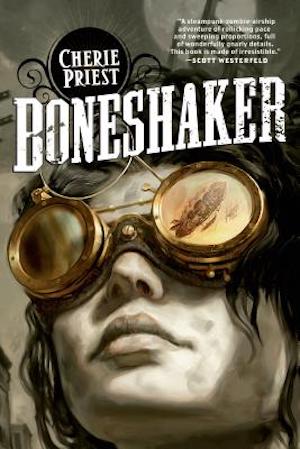
Leviticus Blue’s drilling machine has transformed Seattle: the machine emitted deadly “blight gas,” which changed humans into cannibalistic rotters. Neighboring cities have been forced to wall off the city and its undead inhabitants.
Years later, Blue’s son Ezekiel is determined to clear Blue’s name. The evidence no doubt survives within Seattle. The young man resolves to carry out an expedition into the cursed city. The plan is both bold and suicidal.
Like other zombie apocalypse novels, the apocalypse leads to another long-running American Civil War. This trope appears often enough that there must be a reason that it appeals to the authorial imagination … but I am at a loss to suggest what that reason might be.
The Last Children of Tokyo by Yoko Tawada (2014)
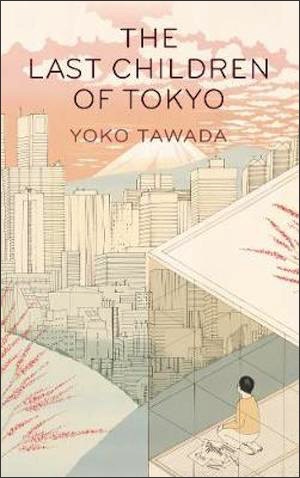
Life in transformed Japan could be upsetting for those who dwell too long on the changes wrought on the island nation’s environment. Accordingly, the government facilitates tranquility by closing Japan to the outside world and uncomfortable comparisons. Citizens are encouraged to conform by an endless barrage of new, poorly heralded laws.
Despite rampant pollution and his advanced age, centenarian Yoshiro is still vigorous. His grandson Mumei is not so lucky. Damaged by pollution, Japan’s children are weak, sickly, and unlikely to enjoy long lives. Yoshiro does his best to tend to Mumei’s needs. After all, without children, does Japan even have a future?
Tawada’s novel is just 138 pages, as short as some novellas. It stands as an example of how much can be accomplished in a slender work, given sufficiently efficient prose. Readers may enjoy as much inexorably escalating tension as may be found in much longer works.
***
Many novels explore environmental transformation’s potential. No doubt I’ve omitted many worthy examples. If your favorites were skipped, feel free to mention them in comments.
In the words of fanfiction author Musty181, four-time Hugo finalist, prolific book reviewer, and perennial Darwin Award nominee James Davis Nicoll “looks like a default mii with glasses.” His work has appeared in Interzone, Publishers Weekly and Romantic Times as well as on his own websites, James Nicoll Reviews (where he is assisted by editor Karen Lofstrom and web person Adrienne L. Travis) and the 2021, 2022, and 2023 Aurora Award finalist Young People Read Old SFF (where he is assisted by web person Adrienne L. Travis). His Patreon can be found here.
[1]The wildfire smoke is being distributed free of charge. How odd that the smoke-affected areas do not seem to be grateful.
[2]Spoiler: the culprit seems to have been mining [rot13] tbyq [/rot13]. This isn’t the only Clement novel in which that element has unexpected properties.










